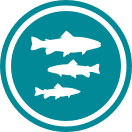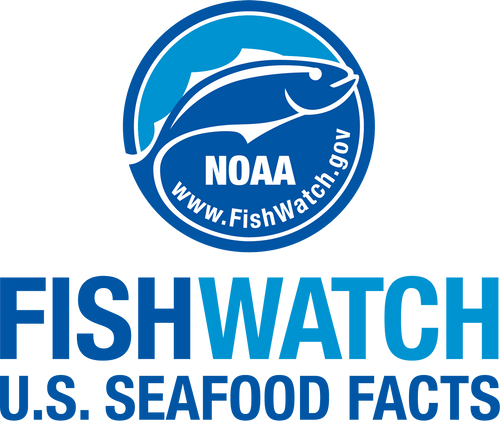 Alaska snow crab. Credit: NOAA Fisheries
Alaska snow crab. Credit: NOAA Fisheries
Alaska snow crab. Credit: NOAA Fisheries
About the Species
 Alaska snow crab. Credit: NOAA Fisheries
Alaska snow crab. Credit: NOAA Fisheries
Alaska snow crab. Credit: NOAA Fisheries
The Alaska snow crab fishery is currently closed because population estimates are below the level required to open a fishery.

Population
The stock is not overfished.

Fishing Rate
Not subject to overfishing.

Habitat Impact
Habitat impacts from crab pots are minor because fishing occurs in areas of soft sediment such as silt and mud that are unlikely to be damaged by fishing gear.

Bycatch
Regulations are in place to minimize bycatch.
Population Status
- According to the 2023 stock assessment, Alaska snow crab is not overfished but still rebuilding, and not subject to overfishing based on 2022 catch data. Summary stock assessment information can be found on Stock SMART.
Appearance
- Alaska snow crabs have a hard rounded shell, four pairs of walking legs, and one pair of claws.
- On top they are brownish in color and underneath they are lighter. Their eyes are green or greenish blue.
- Males and females can be distinguished by the shape of their abdominal flaps. On males this flap is triangular, and on females it is broadly rounded.
Biology
- Male Alaska snow crab can reach 6 inches in shell width but females seldom grow larger than 3 inches.
- Scientists estimate that snow crabs may live for up to 20 years.
- Females can carry up to nearly 100,000 eggs, depending on their size. They hatch their larvae in the spring when there is plenty of food in the water column.
- When the eggs hatch, the larvae look like tiny shrimp.
- The larvae feed on phytoplankton and zooplankton before metamorphosing into tiny crabs and settling on the ocean bottom.
- Alaska snow crabs can only grow by molting (shedding their old shell and growing another).
- After molting snow crabs are soft and vulnerable to predators until their new shell hardens.
- When they have reached sexual maturity, both females and males undergo a “terminal molt,” after which they never molt again.
- Snow crabs will eat almost anything they can catch and break open with their claws, including fish, shrimp, crabs, worms, clams, brittle stars, snails, algae, and sponges. They will also scavenge on anything dead they find.
- Seals, sea otters, octopi, other crabs, and a wide variety of fish prey on Alaska snow crabs.
Where They Live
Range
- Alaska snow crabs are found off the coast of Alaska in the Bering, Beaufort, and Chukchi Seas.
Habitat
- Alaska snow crabs prefer soft sandy or muddy ocean bottoms, typically in water less than 650 feet deep, where they can burrow if threatened by predators and where they can feed on the animals living in the sediment.
Fishery Management
- NOAA Fisheries, the North Pacific Fishery Management Council, and the Alaska Department of Fish and Game manage the Alaska snow crab fishery.
- Managed under the Fishery Management Plan for Bering Sea/Aleutian Islands King and Tanner Crabs, which defers management of crab fisheries to the State of Alaska with federal oversight. State regulations must comply with the fishery management plan, the national standards of the Magnuson-Stevens Act, and other applicable federal laws:
- The Alaska snow crab fishery was closed for fishing years 2022 and 2023. The fishing year runs from July 1 - June 30.
- The Alaska snow crab fishery is currently managed according to the “three S’s” – size, sex, and season. Only male crabs of a certain size may be harvested, and fishing is not allowed during mating and molting periods. These measures help ensure that crabs are able to reproduce and replace the ones that are harvested.
- Every year, managers set the harvest limit for the next fishing season using the most recent estimates of crab abundance.
- Managers allocate shares of the harvest among harvesters, processors, and coastal communities through the crab rationalization program, which was implemented in 2005 to address economic, safety, and environmental issues in the fishery. This program includes a community development quota, which protects community interests by allowing community groups 10 percent of the harvest. They’re given the opportunity to purchase shares in the fishery before the shares are offered for sale outside the community.
- Vessels carry vessel monitoring systems (satellite communications systems used to monitor fishing activities) and must report their landings electronically.
- Fishermen must install escape panels and rings on their pots to prevent ghost fishing (when lost pots continue to capture and kill species) and to reduce bycatch.
- Managers monitor catch in real time and are able to close the fishery when the harvest limit is reached.
- A rebuilding plan to rebuild the stock to the target population level is in place with a target date of 2029.
- Observers are required on 20 percent of the vessels in the fishery. They collect data on catch and bycatch and document any violations of fishing regulations.
Harvest
- In 2022, commercial landings of Alaska snow crab totaled 5.5 million pounds and were valued at 24.5 million, according to the NOAA Fisheries commercial fishing landings database.
- Gear types, habitat impacts, and bycatch:
- The fishing fleet is made up of a variety of vessels, from small inshore vessels to large-scale “super crabbers” that fish in the Bering Sea.
- Commercial fishermen use crab pots to harvest snow crab.
- They bait the pots with chopped herring, mackerel, or squid and lower the pots over silt and mud ocean bottoms. After a couple days, fishermen haul the pots back on board, empty them, and sort the catch – then start all over again.
- Crab pots can unintentionally catch female crabs (which may not be harvested), males under the commercial size, and non-targeted crab species as well as a small number of other species including octopus, Pacific cod, Pacific halibut, other flatfish, sponges, coral, and sea stars.
- Management requires fishermen to install escape panels and rings on their pots to prevent ghost fishing (when lost pots continue to capture and kill species) and to reduce bycatch.
Scientific Classification
- Alaska snow crabs are found off the coast of Alaska in the Bering, Beaufort, and Chukchi Seas.
- Alaska snow crabs prefer soft sandy or muddy ocean bottoms, typically in water less than 650 feet deep, where they can burrow if threatened by predators and where they can feed on the animals living in the sediment.
Fishery Management
- NOAA Fisheries, the North Pacific Fishery Management Council, and the Alaska Department of Fish and Game manage the Alaska snow crab fishery.
- Managed under the Fishery Management Plan for Bering Sea/Aleutian Islands King and Tanner Crabs, which defers management of crab fisheries to the State of Alaska with federal oversight. State regulations must comply with the fishery management plan, the national standards of the Magnuson-Stevens Act, and other applicable federal laws:
- The Alaska snow crab fishery was closed for fishing years 2022 and 2023. The fishing year runs from July 1 - June 30.
- The Alaska snow crab fishery is currently managed according to the “three S’s” – size, sex, and season. Only male crabs of a certain size may be harvested, and fishing is not allowed during mating and molting periods. These measures help ensure that crabs are able to reproduce and replace the ones that are harvested.
- Every year, managers set the harvest limit for the next fishing season using the most recent estimates of crab abundance.
- Managers allocate shares of the harvest among harvesters, processors, and coastal communities through the crab rationalization program, which was implemented in 2005 to address economic, safety, and environmental issues in the fishery. This program includes a community development quota, which protects community interests by allowing community groups 10 percent of the harvest. They’re given the opportunity to purchase shares in the fishery before the shares are offered for sale outside the community.
- Vessels carry vessel monitoring systems (satellite communications systems used to monitor fishing activities) and must report their landings electronically.
- Fishermen must install escape panels and rings on their pots to prevent ghost fishing (when lost pots continue to capture and kill species) and to reduce bycatch.
- Managers monitor catch in real time and are able to close the fishery when the harvest limit is reached.
- A rebuilding plan to rebuild the stock to the target population level is in place with a target date of 2029.
- Observers are required on 20 percent of the vessels in the fishery. They collect data on catch and bycatch and document any violations of fishing regulations.
Harvest
- In 2022, commercial landings of Alaska snow crab totaled 5.5 million pounds and were valued at 24.5 million, according to the NOAA Fisheries commercial fishing landings database.
- Gear types, habitat impacts, and bycatch:
- The fishing fleet is made up of a variety of vessels, from small inshore vessels to large-scale “super crabbers” that fish in the Bering Sea.
- Commercial fishermen use crab pots to harvest snow crab.
- They bait the pots with chopped herring, mackerel, or squid and lower the pots over silt and mud ocean bottoms. After a couple days, fishermen haul the pots back on board, empty them, and sort the catch – then start all over again.
- Crab pots can unintentionally catch female crabs (which may not be harvested), males under the commercial size, and non-targeted crab species as well as a small number of other species including octopus, Pacific cod, Pacific halibut, other flatfish, sponges, coral, and sea stars.
- Management requires fishermen to install escape panels and rings on their pots to prevent ghost fishing (when lost pots continue to capture and kill species) and to reduce bycatch.
Scientific Classification
| Kingdom | Animalia | Phylum | Arthropoda | Class | Malacostraca | Order | Decapoda | Family | Oregoniidae | Genus | Chionoecetes | Species | opilio |
|---|
Last updated by NOAA Fisheries on 09/09/2024
Featured News
 Three snow crabs. Credit: NOAA Fisheries
Three snow crabs. Credit: NOAA Fisheries
 Juvenile coho salmon. Credit: iStock
Juvenile coho salmon. Credit: iStock
Seafood Facts

Is Alaska Snow Crab Sustainable?
U.S. wild-caught Alaska snow crab is a smart seafood choice because it is sustainably managed and responsibly harvested under U.S. regulations.
Availability
Generally harvested from January to April in the Eastern Bering Sea, but available year-round.
Source
U.S. wild-caught in Alaska.
Taste
Sweet.
Texture
Delicate and flaky.
Color
The snow-white meat is what gives the snow crab its name and its reputation as a delicacy.
Health Benefits
Alaska snow crab is a low-fat source of protein.
Nutrition Facts
Servings: 1; Serving Weight: 100 g (raw); Calories: 90; Protein: 18.5 g; Total Fat: 1.18 g; Total Saturated Fatty Acids: 0.143 g ; Carbohydrate: 0 g; Total Sugars: 0 g; Total Dietary Fiber: 0 g; Cholesterol: 55 mg; Selenium: 34.6 mcg; Sodium: 539 mgSustainable Seafood Recipes
Looking for a new seafood recipe or an old favorite? If you need some cooking inspiration, browse these seafood recipes for main dishes, appetizers, sides, and more!
Last updated by NOAA Fisheries on 09/09/2024
Seafood News
 Tonya Wick aboard a fishing vessel at sea in 1998. Photo courtesy of Tonya Wick
Tonya Wick aboard a fishing vessel at sea in 1998. Photo courtesy of Tonya Wick
 Fish on display at the market. Credit: Shutterstock
Fish on display at the market. Credit: Shutterstock
 A signboard thanking patrons at Tuna Harbor Dockside Market in San Diego. Credit: Tuna Harbor Dockside Market.
A signboard thanking patrons at Tuna Harbor Dockside Market in San Diego. Credit: Tuna Harbor Dockside Market.
Science Overview

NOAA Fisheries conducts various research activities on the distribution and abundance of Alaska snow crab. The results of this research are used to inform management decisions for this species.
For detailed information about stock status, management, assessments, and resource trends, you can search for Alaska snow crab, and any other species of interest, using NOAA's StockSMART web tool.
Alaska Snow Crab in the Eastern Bering Sea
Our research in Alaska on the growth, reproduction, diet, distribution, and juvenile habitat of Alaska snow crab provides information crucial for understanding and managing this species.
More Information
Recent Science Blogs
Last updated by NOAA Fisheries on 09/09/2024
Documents
Draft 2024 Eastern Bering Sea Crab Technical Memorandum
This is a draft Technical Memo that includes preliminary results from the 2024 eastern Bering Sea…
Draft 2023 Eastern Bering Sea Crab Technical Memorandum
This is a draft Technical Memo that includes preliminary results from the 2023 eastern Bering Sea…
Draft 2022 Eastern Bering Sea Crab Technical Memorandum
This is a draft Technical Memo that includes preliminary results from the 2022 eastern Bering Sea…
Profiles of Fishing Communities of Alaska
In-depth profiles of the 196 Alaska communities most involved in Alaskan and North Pacific…
Data & Maps
2021 Alaska Fisheries Economic Status of the Bering Sea and Aleutian Islands King and Tanner Crab
This Fisheries Management Plan includes all species and fisheries for Alaska crab (red, blue, and…
2020 Alaska Crab Stock Assessment And Fishery Evaluation Report
This Fisheries Management Plan includes all species and fisheries for Alaska crab (red, blue, and…
2019 Alaska Fisheries Economic Status of the Bering Sea and Aleutian Islands King and Tanner Crab
This executive summary highlights three sets of primary indicators describing aggregate changes in…
2019 Alaska Crab Stock Assessment and Fishery Evaluation Report
This Fisheries Management Plan includes all species and fisheries for Alaska crab (red, blue, and…
Research
Frequent Questions—Snow Crab and Salmon Declines in Alaska
NOAA Fisheries answers questions about what is behind the declines in snow crab and salmon and how we are addressing them.
Alaska Crab Stock Assessment and Fishery Evaluation Reports
Crab Stock Assessment and Fishery Evaluation Reports from 1998–2021.
Alaska Shellfish Additional Research
Handling Mortality During the Bering Sea Snow and Southern Tanner Crab Fishery The southern Tanner crab, Chionoecetes bairdi, and the snow crab, Chionoecetes opilio, that are discarded during the commercial fishery, suffer an unknown amount of…
Alaska Shellfish Reproduction Research
Reproduction Potential of Bristol Bay Red King Crab Female red king crab brooding a clutch of eggs. Stock assessment and management of Alaskan red king crab may be improved by incorporating reproductive output, which requires an…
Last updated by NOAA Fisheries on 09/09/2024







